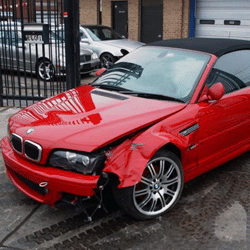Radiator and Cooling System
Maintaining your car’s cooling system should be the second most important task next to the engine. Engines create friction and even the best motor oils cannot stop all the friction. Friction creates heat, which can break down the oil, making it less effective, leading to permanent damage to the motor. This is where the cooling system comes in to get rid of the heat as quickly and efficiently as possible to keep your engine at a safe operating temperature.
Your car’s cooling system consists of the radiator, fan, water pump, thermostat, sensors, an overflow tank, coolant, belts and a number of clamps and hoses to connect everything into one system. The water pump directs fluid past the hottest portion of your engine towards the radiator, past a thermostat to record the temperature, into the radiator where the fan cools it allowing the heat to dissipate into the air. The cooled water then returns to the water pump and the whole process starts over. If the thermostat detects a temperature that is above a normal operating temperature, your temperature gauge will rise and let you know that something is not working correctly. Unless you have fixed a problem with overheating before or are capable of doing so, it is best to have the car towed to your mechanic to find and fix the problem to avoid causing damage to your motor by driving it.
The fluid that is pumped through your cooling system is a combination of coolant and water. Coolant contains a chemical called ethylene glycol, which bonds with the molecules in water to increase the temperature it needs to reach before it boils, and decrease the temperature the water needs to reach before it freezes, it also helps to inhibit rust formation by changing the chemical properties of the water. For most climates you should use a 50/50 mix, for more extreme climates it is probably a better idea to use a 70/30 mix of coolant/water. The biggest thing you need to watch for is leaks, your first sign the system is leaking is that the temperature gauge will register higher than normal. You also want to watch for pools of greenish looking fluid under the front of your car. (If you vehicle is leaking, please be kind and clean it up, ethylene glycol can be fatal to both children and animals and has a sweet taste that attracts both). If you answer yes to both of these questions, your cooling system has a leak and you want to get it towed to your mechanic as soon as possible to have it repaired.
If you do not see any obvious leaks or hear any hissing noises that may indicate a hole in hose or the radiator, you might want to make sure that you have adequate fluid in the system. If you vehicle is hot, NEVER open the cover or your radiator, let it cool overnight before you decide to open it and see if your radiator has any fluid in it. Once it is cool, there are two places to check to make sure that you have adequate fluid in your cooling system. The first is your overflow tank, which is a clean tank with markings on it that denote full hot and full cold. If you are checking the vehicle while it is cool and the bottle is empty, chances are your radiator is low on fluid. This is when you want to open the radiator and see if there is any fluid visible and if there is not, you need to fill it. You can purchase premixed coolant if you are topping off your radiator as it takes the guesswork out of making sure you have the right amount of coolant. Fill your radiator to the top, replace the cap, and drive the vehicle for a day or so, then recheck the overflow. If it is still low, let the car cool and add more to the radiator, if it is reading full hot when it should, and full cold when it should, your problem is solved.
Brakes
The braking system, much like the transmission, is a sealed system, so there should never be a need to replace a large amount of brake fluid. Brake fluid will evaporate over time, but if you have to add more than a few tablespoons to bring it to the full point, you may have a problem somewhere in your braking system. If you find yourself adding fluid every week, you need to take your car to your mechanic and have your brake system inspected to find out what the problem is. Leaky brakes are not something to be taken lightly. You also want to be sure that you check the fluid reservoir in a garage or under an overhang, as you do not want to expose any water to the brake fluid.
Battery
Most cars have “maintenance-free” batteries. This means the battery is sealed and requires no intervention by the vehicle owner. These do not require maintenance, however after a period of years or if you start having starting problems with your car, it does need to be replaced. If you have the older style of battery that has six cells that hold water, just get rid of it. These batteries can expose you to battery acid, which is mostly composed of hydrochloric acid, which can cause serious burns or blindness if you get it in your eyes. They are also very apt to exploding especially if they are old. Save yourself the trouble and possible injuries and replace it with a maintenance free battery, you will be better off in the end.
Windshield Washer Fluid
Most people simply just forget to check the level of their windshield washer fluid and do not realize it is low until they actually try to use it and it is empty. Most newer vehicles have an indicator that will trigger a light on your dash to tell you when the fluid is low. Pay attention to this to save yourself from not having windshield washer fluid when you really may need it. The washer fluid reservoir is located under the hood and usually is marked on the lid with a picture of windshield wipers. It is usually a large reservoir, which is why washer fluid is normally sold in gallon containers. A reservoir that is completely empty, depending on the make and model of car you drive, will take the whole gallon of washer fluid.
For those that drive SUV’s or minivans with rear window wipers, or even high-end cars that have headlight wipers, make sure that you fill any additional reservoirs that might be used to provide fluid to these components as well. In most cases, the headlight wipers use the same reservoir as the windshield wipers, but you still want to make sure, so they are all filled. The rear window wipers usually have their own reservoir located near the rear of the vehicle or even in the rear door. If you cannot locate additional reservoirs, check your owner’s manual to help you find them.
Air Conditioning
This is one system on your vehicle you should leave to the professionals. If your air conditioning is not quite blowing air that is cold as it was last summer, or is not blowing cold air at all, make an appointment with your mechanic to have it recharged. They have the tools and products as well as the expertise to recharge your system quickly and easily, and it is well worth paying someone else to do it.
Summary
Your car is an investment and requires maintenance. The more proactive you are with your car, the quicker you will catch potentially expensive problems, and the better condition your car will be in. A well-maintained car holds its value much better than one that was “sort of” taken care of. If you are not comfortable with doing any of the maintenance, take it to your mechanic and let them do it. It is better to pay someone else to do something instead of you doing it wrong and it costing you much more than it would have in the first place.




 Follow
Follow

